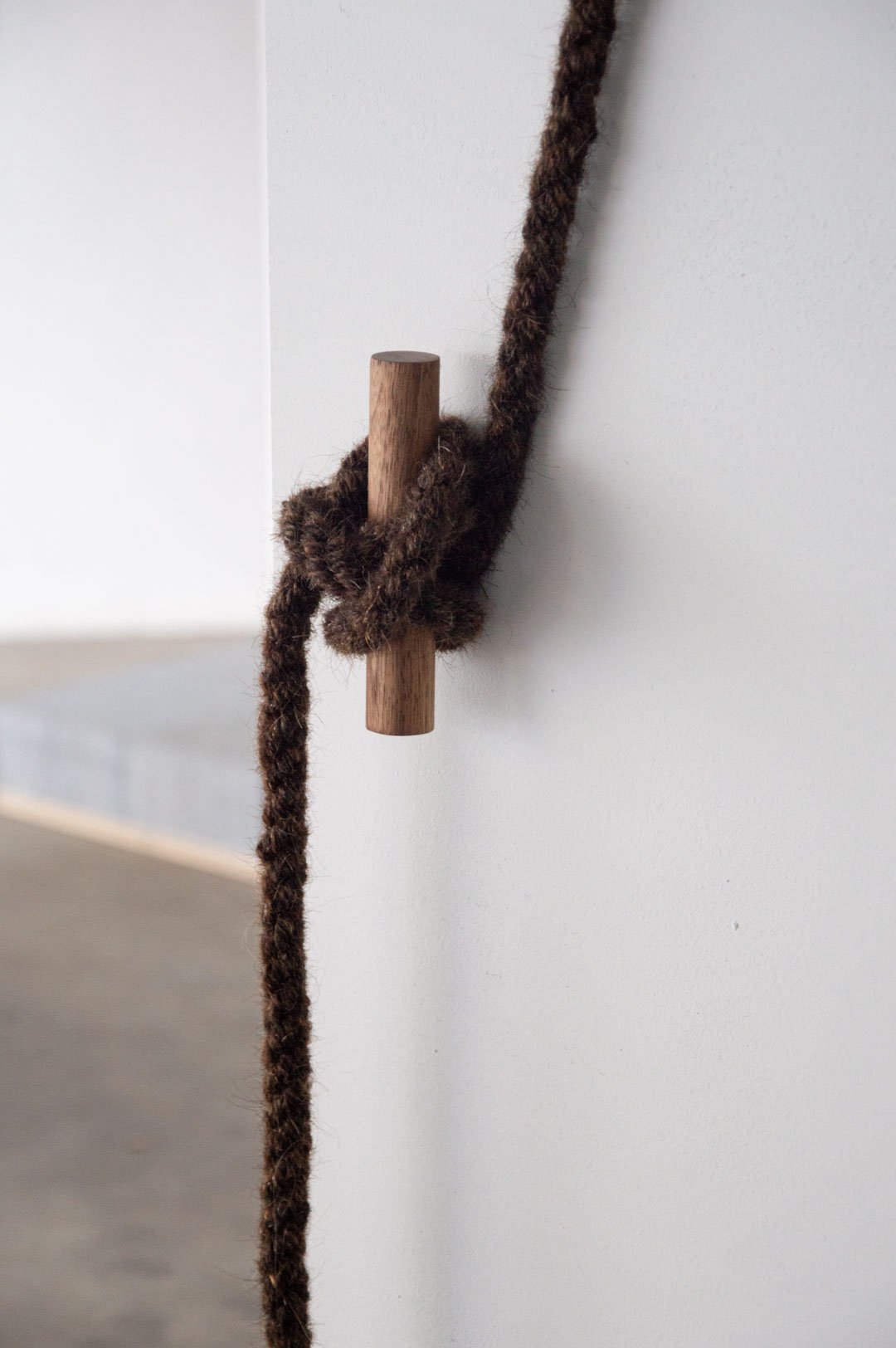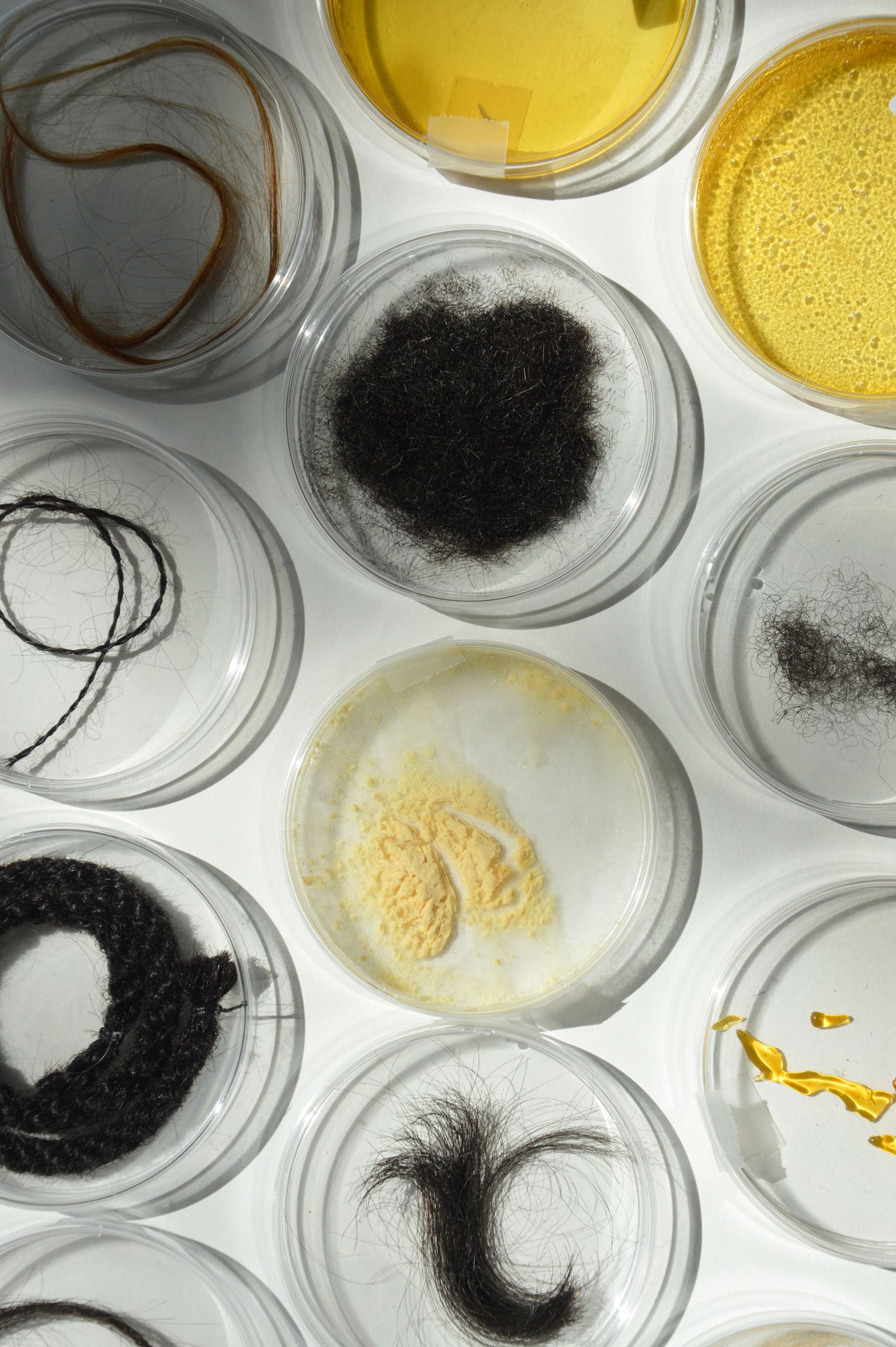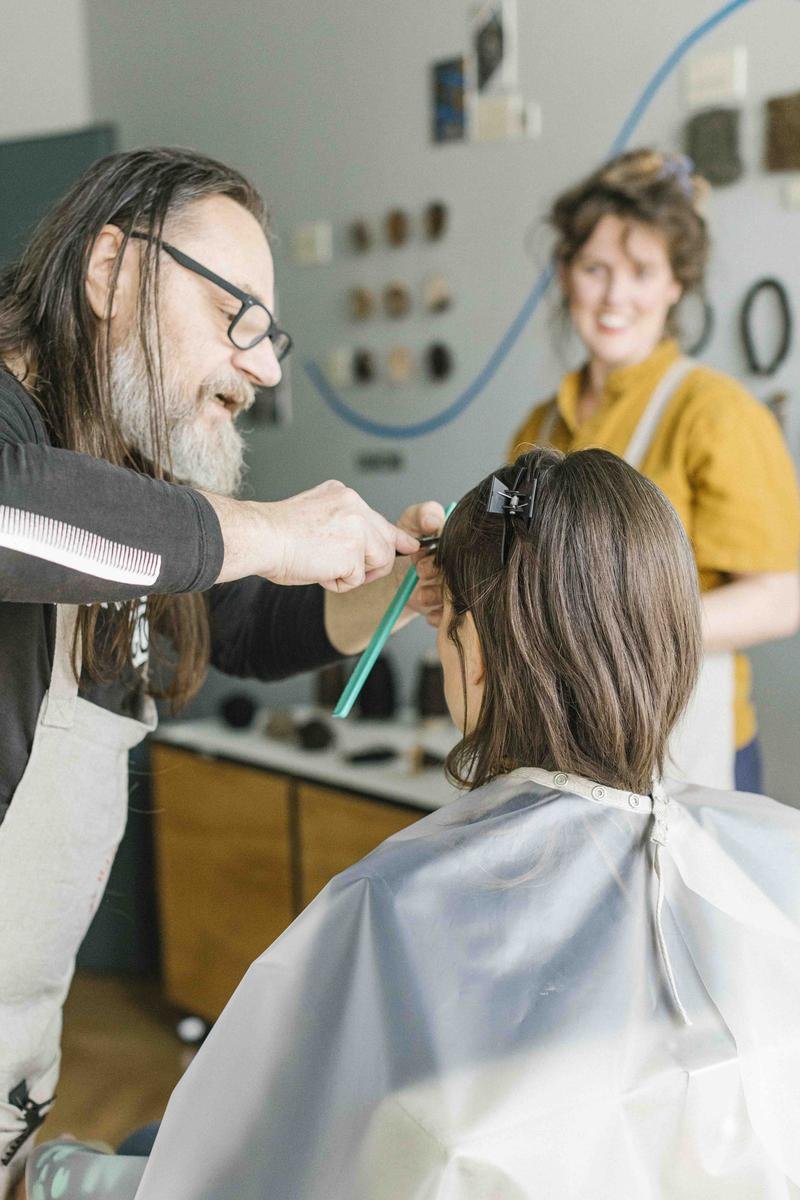Cut and Good
Hair Material Research by Sanne Visser
It constantly grows, is robust and natural - but is usually thrown away: Human hair is a magical material that can be used for textiles and oil filters, for example. Designers like Sanne Visser are committed to utilising this unused potential - in doing so, they also touch on ethical issues.
In a world of finite resources, the focus is increasingly shifting to renewable materials from nature. At first glance, it may come as a surprise that this includes human hair. However, if you look at the quantities of this natural material, you wonder why it hasn't been used for a long time. A person has around 100,000 hairs on their head. Germans, for example, go to the hairdresser an average of 6.5 times a year. It is estimated that around 700,000 tonnes of human hair is produced as waste worldwide every year. The majority of this is not recycled, but ends up in the rubbish bin. But there are creative minds who want to change this by using human hair as a naturally renewable raw material - for oil filters and textiles, for example.
Human Material Loop from the Netherlands produces textiles for fashion and interior design from human hair using industrial processes. Image © Human Material Loop
Robust, resistant and easy to clean
In recent years, anyone who came to Milan for Design Week could have their hair cut for free - and hand in material that could be reused. In 2024, Szofia Kollar from Human Material Loop in Geelen, the Netherlands, did this as part of an exhibition, followed a year earlier by Sanne Visser, who also comes from the Netherlands but now lives in London. Both are convinced that the use of human hair has great potential, as it is abundant, has impressive qualities and is completely recyclable. While Human Material Loop has only recently come onto the scene, Sanne Visser is something of a pioneer of design with human hair. Since 2016, Sanne has specialised in this with her work "The New Age of Trichology". Born in 1992, the designer pursues an artisanal, experimental and artistic approach, while Human Material Loop aims to incorporate hair as a material in industrial textile manufacturing processes.
Human hair is a truly miraculous material. It is particularly strong: scientists have discovered that a single hair can carry 100 grams, so you could hang two elephants from one head of hair. Human hair is also relatively resistant to chemicals and heat. It binds fat, which we can see in our own hair every day. And hair is easy to care for - it doesn't actually need detergent to get clean. It is these benefits that have led makers around the world to explore human hair as a material in recent years.
For the “EXTENDED” series, Sanne Visser only worked with recycled material: human hair and broken mirrors that she found on the streets of London. Image © Sanne Visser
Newly developed biomaterials using the extracted keratin from hair to create a plastic like material by Sanne Vissser, 2022
Newly developed biomaterials using the extracted keratin from hair to create a plastic like material by Sanne Vissser, 2022
100 per cent handmade and natural
Sometimes people are initially reluctant to donate their hair for processing, says Sanne Visser, who holds a Master's degree in Material Futures from Central Saint Martins. But as soon as you explain to them what the hair will be used for, most of them agree. "They actually really like it." Sanne processes the hair into ropes, nets, bioplastics and, together with textile designer Sofia Hott, also into textiles - all 100 per cent handmade. The fascinating thing is that the hair does not have to be chemically processed. Sanne sorts the hair she receives from hairdressers in London according to length and colour. Sanne can only use hair from a length of two centimetres - which is not the rule, however, because people usually only have a few centimetres cut off. The hair is then washed and spun by hand. She uses her self-developed Ropemachine 2.0 to twist the yarns into ropes that is integrated for mirror mounts, for example. You can even buy dog leads made from human hair from Sanne Visser. The "closed-loop approach" of her project is important to the designer: "We have to understand the entire cycle. How we live and what we eat affects the health of the hair. All of this can later end up in the soil."
A symbol of life and strength
We are familiar with wigs made of human hair. But we feel a little queasy when we imagine human hair being processed into other consumer goods. This is also due to cultural history. After all, hair symbolises life, growth, youth and identity. Hair that has fallen out or been cut off, on the other hand, is associated with the end of life, ageing, loss of personality or even death. In the "Book of Judges" in the Old Testament, it is said that the divine power of the hero Samson lay in his seven locks of hair. Delilah used a trick to cut off his hair and rob Samson of this power.
In past centuries, hair was valuable and was carefully preserved or passed on to loved ones. Since the Middle Ages, objects made of human hair have served as mementos of a person. Brooches, necklaces or bracelets made of hair were worn or kept as a sign of friendship or mourning. The British Queen Victoria, who wore a locket with a lock of her deceased husband's hair, was particularly famous for this. In the 19th century, hair pictures and hair wreaths were popular, which were woven, braided or bobbin lace and served as a memento. In addition to women from the Dalarna region of Sweden, who travelled around northern Europe to offer such services, it was mail-order companies in the USA that produced these works from hair that had been sent in. This cult of remembrance was later replaced by photographs. The fact that hair is linked to identity and dignity is also shown by a dark chapter in European history: the German National Socialists cut off the hair of Jewish fellow citizens in concentration camps on the very first day in order to degrade them. The hair was sold to the textile industry to make slippers, for example.
Hair is made of the same material as fingernails and toenails: horn. The keratin-containing, thread-like structure with a diameter of 40-120 micrometres grows about one centimetre per month and consists of three structures that build on each other: the thick, scale-like protective, the cuticle, which surrounds the cortex of spindle-shaped cells, which in turn encloses the hair protein. Hair can absorb water in liquid or vapour form, which is used for hygrometers that measure relative humidity using so-called hair harps. In criminal research, the cuticle structure and DNA of hair are used to identify people.
At ‘Locally Grown’ project by Sanne Visser in cooperation with hairdressers during Milan Design Week 2023, visitors could have their hair cut off and donate it. Image © Sanne Visser
Hairdressers as farmers
Working with human hair as a (rediscovered) material for everyday objects is still in its infancy. Sanne Visser is also continuing to develop her design and enjoys researching a holistic approach, "whole system thinking". Together with other designers, as part of her “Locally Grown” project supported by Design Museum, British Council amongst others, she is asking herself how hairdressers can be involved in the process, how they can become farmers, so to speak.
Oil mats made from human hair help to prevent oil pollution in water, as hair naturally binds fat to itself. Image © FettFressHair
Cutting against the oil spill
Thierry Gras has already been able to establish a functioning system. The hairdresser from near Marseille collects hair in France, but also in neighbouring countries such as Spain, Portugal, Switzerland and Germany, using public donation containers into which hairdressers can deposit the remains of their day's work. Thierry uses the hair for his organisation Coiffeurs Justes, which uses it to make oil mats. These mats are used for oil spillages, particularly in waters. "The first time this was practised was in Bretagne in 1978, when an oil spill there gave fishermen the idea of putting cut-off hair in their wives' nylon tights to get the oil out of the sea," explains Thierry. One kilogram of hair can bind up to eight litres of oil. This has now become a large network - a total of 4,500 hairdressing salons in France collect for Coiffeurs Justes. The mats can be washed and reused up to eight times. In Germany, Nadine Falke is active in a similar way with FettFressHair.
Furthermore, the fact that humans, like sheep or goats, can supply hair for the value chain touches on ethical and philosophical considerations that are currently being discussed under buzzwords such as multispecies turn or posthumanism. Such approaches no longer place humans at the pinnacle of evolution, but on the same level as other living beings such as animals and plants. In this respect, projects such as those by Sanne Visser, Zsofia Kollar, Nadine Falke and Thierry Gras with human hair also help us to reflect on our precarious relationship with nature, which has so far been based on hierarchy and exploitation.
INFO
Featured Designers and Makers
Sanne Visser
Instagram @studiosannevisser
Human Material Loop
https://humanmaterialloop.com/
Instagram @humanmaterialloop
Coiffeurs Justes
Instagram @coiffeurs_justes
FettFressHair
Instagram @fettfresshair
WORDS
Martina Metzner believes that good design and sustainability are inextricably linked. As a journalist for design and architecture based in Frankfurt/Main she publishes with a focus on socio-ecological transformation and materials. After studying journalism, Italian philology and psychology, she worked in editorial offices for eleven years, first at TextilWirtschaft and then at Stylepark. Since 2018, she works freelance for trade and consumer magazines and leads the editorial content at Deutscher Design Club.








